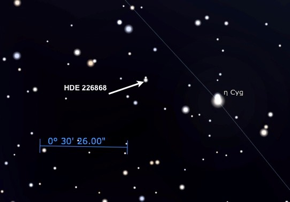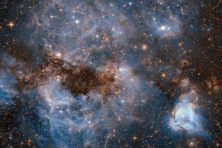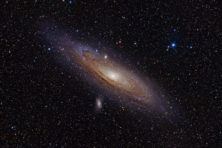Eye On the Night Sky: Cygnus, The Northern Cross
- Share
- Tweet
- Pin
- Share

by Tom Minahan
Would you like to see a black hole? Well, you can’t and no one can because the strong gravitational field near a black hole prevents even light from escaping out into space. Would you like to see a star that co-orbits a small black hole? You can – with binoculars! It’s a dim star (from Earth) in the constellation Cygnus the Swan, also known as The Northern Cross.
“Black Hole” is a term coined by physicist John Wheeler in the 1960s to describe an object so massive and so dense that the escape velocity near the object – how fast anything must travel away from a large mass to counteract its gravitational pull – equals or exceeds the speed of light, c. c = 300,000 km/sec in a vacuum. Even though Karl Schwarzschild derived the theoretical possibility of black holes in 1916 using Einstein’s General Theory of Relativity, few astronomers in the 1960s believed in the existence of these “collapsars.” When X-ray detectors were first flown on rockets (X-rays, gamma rays and ultraviolet light are blocked by the upper atmosphere), a strong source was found near a star in Cygnus, designated HDE 226868. Theory predicts that when swirling gas and dust is pulled toward a black hole, it is superheated and emits radiation across the spectrum, including X-rays.
Subsequent observations of HDE 226868 gave strong evidence that the X-ray source was the first inferred black hole, designated Cygnus X-1. Being the most studied astronomical object in its class, the compact object is now estimated to have a mass of ∼16 solar masses (Sun = 1) and has been shown to be too small to be any known kind of star or other likely object besides a black hole. If so, the radius of its event horizon (the point of no return for light or matter) is about 44 km. It co-orbits a ∼27 solar-mass blue supergiant variable star at a distance of 0.2 Astronomical Units, or 20 percent of the distance from the Earth to the Sun. A stellar wind from the star provides material for an accretion disk around the X-ray source. Matter in the disk is heated to millions of degrees, generating the observed X-rays.
Where is HDE 226868/Cygnus X-1 in the evening sky? The constellation Cygnus is overhead all summer, between Lyra (the small parallelogram) and Pegasus (the big square). It looks like a flying swan with its long neck pointed south along the Milky Way. With a dark, clear sky and a decent pair of binoculars, find the bright star in the middle of the neck, called Eta Cygnus, or η Cyg. Referring to the star plot shown, find the rectangle of stars nearby; HDE 226868 is the star about halfway between η Cyg and the rectangle. The star looks dim because it is 6,070 light-years away, but light from a giant star that is slowly being sucked into a black hole is now striking your retina. Good thing it escaped!
Cygnus X-1 is considered to be small, as black holes go; it’s called a stellar mass black hole, even though it’s more massive than the Sun. Most galaxies appear to have a supermassive black hole at their centers, some as large as 30 billion solar masses. Intermediate-sized black holes also exist. The black hole at the center of our Milky Way galaxy, Sagittarius A*, is about 4.5 million solar masses. Cosmologists theorize that these supermassive black holes drive the formation and evolution of galaxies.
Gravitational waves, predicted by Einstein, were recently detected for the first time by two ridiculously sensitive laser interferometers in Louisiana and Washington. These waves are the faint ripples of spacetime from the merger of two black holes about 1.3 billion lightyears away. The interferometers detected the compression and stretching of space by a small fraction of the width of one proton! This faint signal revealed a tremendous collision that took place in a fraction of a second, but released 3 solar masses of gravitational energy (E = mc2). This computes to more than 50 times the energy radiated by all the stars in the universe combined! A long time ago in a galaxy far, far away indeed.
“Eye On the Night Sky” is a monthly column by the Door Peninsula Astronomical Society. For more information on the organization, visit DoorAstronomy.org.




